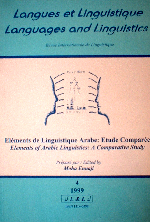pp. 1-17
JANET C.E. WATSON
Abstract
Traditionally, CVVC and CVCC
syllables in Arabic have been analysed as superheavy syllables comprising a
canonical bimoraic syllable and a degenerate syllable. Recent work on modern
Arabic dialects, however, has shown that CVVC and CVCC syllables are not
prosodically identical: in many eastern dialects, CVVC syllables are
attested word-internally in derived environments while CVCC syllables are
attested in word-final position only. Stress patterns in San’ani Arabic, a
dialect of Yemeni Arabic, provide a further interesting example of
asymmetries between CVVC and CVCC syllables. While in most Arabic dialects
word-final CVVC and CVCC syllables invariably attract word stress, in
San’ani word-final CVCC attracts stress but CVVC attracts stress iff the
penultimate or antepenultimate syllable is neither CVV or CVG (i.e.
CVGeminate). Where the penultimate or antepenultimate syllable is CVV or CVG
stress is assigned to this syllable and not to word-final CVVC. In the
discussion, I consider Broselow et al’s (1992, 1995, 1997) bimoraic analysis
of word-internal CVVC syllables and suggest that the rather unexpected
behaviour of word-final CVVC syllables vis-a-vis CVCC syllables can also be
attributed to the wide sonority distance between adjacent V and C. This
sonority distance allows the latter portion of the long vowel and the final
consonant in CVVC syllables to share a mora word-internally through
Broselow’s Adjunction-to-Mora rule, and, by extension, for the final C of
word-final CVVC syllables to be treated as extrametrical as opposed to
extrasyllabic. The final extrametrical consonant links directly to the
syllable node giving final CVVC peripherality which allows it to be treated
as an extrametrical bimoraic foot.
The stress patterns of words with
final CVVC syllables also highlights a weight distinction between CVG and
CVC syllables: while CVG syllables are always treated as heavy by stress
rules, CVC syllables are treated as heavy iff they fall in the environment
of other CVC syllables or light (CV) syllables; in the environment of final
CVVC or word-internal CVV and CVG syllables, CVC syllables are treated as
light and fail to be stressed. To account for the dual nature of CVC
syllables in San’ani, I propose a two-layered syllable-internal grid in
which CVC syllables are represented as bimoraic on the lower layer but as
monomoraic on the upper layer, whereas CVG syllables (like CVV syllables)
are treated as bimoraic on both the lower and upper layers.
